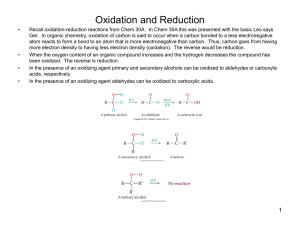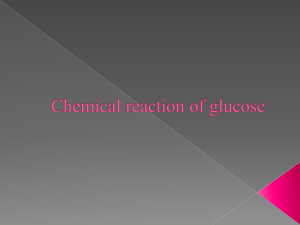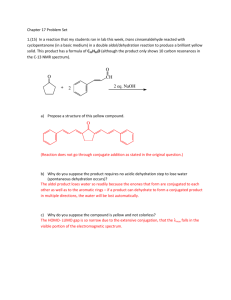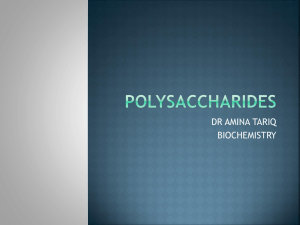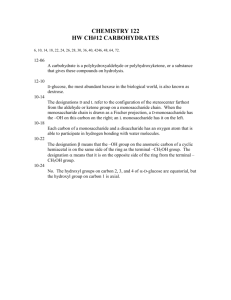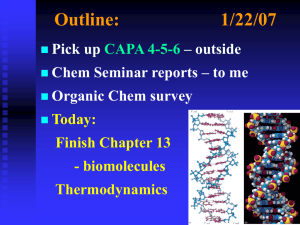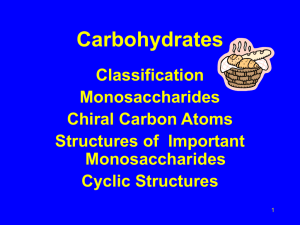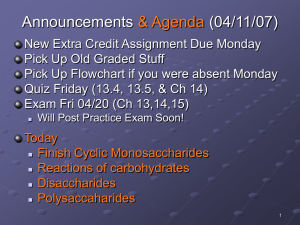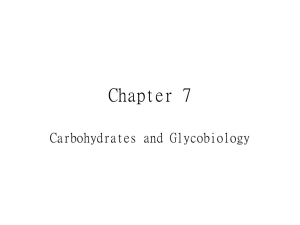I (CH O)
advertisement
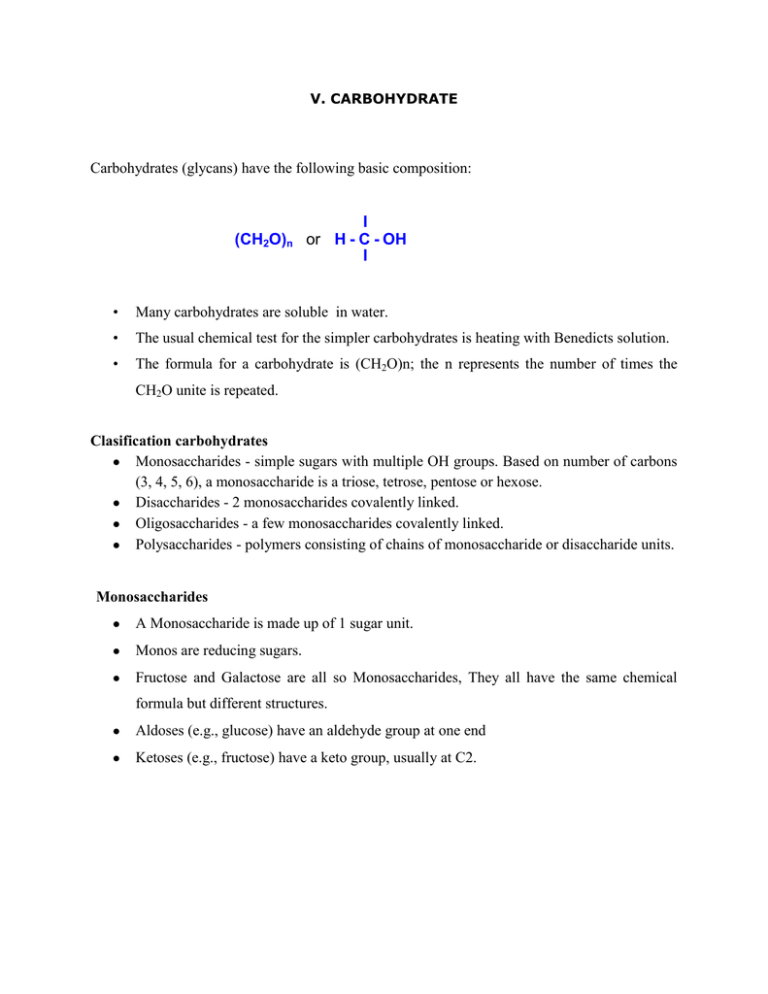
V. CARBOHYDRATE Carbohydrates (glycans) have the following basic composition: I (CH2O)n or H - C - OH I • Many carbohydrates are soluble in water. • The usual chemical test for the simpler carbohydrates is heating with Benedicts solution. • The formula for a carbohydrate is (CH2O)n; the n represents the number of times the CH2O unite is repeated. Clasification carbohydrates Monosaccharides - simple sugars with multiple OH groups. Based on number of carbons (3, 4, 5, 6), a monosaccharide is a triose, tetrose, pentose or hexose. Disaccharides - 2 monosaccharides covalently linked. Oligosaccharides - a few monosaccharides covalently linked. Polysaccharides - polymers consisting of chains of monosaccharide or disaccharide units. Monosaccharides A Monosaccharide is made up of 1 sugar unit. Monos are reducing sugars. Fructose and Galactose are all so Monosaccharides, They all have the same chemical formula but different structures. Aldoses (e.g., glucose) have an aldehyde group at one end Ketoses (e.g., fructose) have a keto group, usually at C2. H O CH2OH C C O HO C H OH H C OH OH H C OH H C OH HO C H H C H C CH2OH CH2OH D-glucose D-fructose D & L designations are based on the configuration about the single asymmetric C in glyceraldehyde.The lower representations are Fischer Projections. CHO CHO H C OH HO L-glyceraldehyde CHO H C OH CH2OH D-glyceraldehyde H CH2OH CH2OH D-glyceraldehyde C CHO HO C H CH2OH L-glyceraldehyde For sugars with more than one chiral center, D or L refers to the asymmetric C farthest from the aldehyde or keto group. Most naturally occurring sugars are D isomers. O H C H – C – OH HO – C – H H – C – OH H – C – OH CH2OH D-glucose O H C HO – C – H H – C – OH HO – C – H HO – C – H CH2OH L-glucose D & L sugars are mirror images of one another. They have the same name, e.g., D-glucose & Lglucose. Other stereoisomers have unique names, e.g., glucose, mannose, galactose, etc. The number of stereoisomers is 2n, where n is the number of asymmetric centers. The 6-C aldoses have 4 asymmetric centers. Thus there are 16 stereoisomers (8 D-sugars and 8 L-sugars). Hemiacetal & hemiketal formation An aldehyde can react with an alcohol to form a hemiacetal. A ketone can react with an alcohol to form a hemiketal. H C H O + R' OH R' O C R R aldehyde alcohol hemiacetal R C OH R O + "R OH "R O C R' OH R' ketone alcohol hemiketal Pentoses and hexoses can cyclize as the ketone or aldehyde reacts with a distal OH. Glucose forms an intra-molecular hemiacetal, as the C1 aldehyde & C5 OH react, to form a 6-member pyranose ring, named after pyran. These representations of the cyclic sugars are called Haworth projections. 1 H HO H H 2 3 4 5 6 CHO C OH C H C OH (linear form) C OH D-glucose CH2OH 6 CH2OH 6 CH2OH 5 H 4 OH O H OH 3 H H 1 H 2 OH -D-glucose OH 5 H 4 OH H OH O OH H 1 2 3 H H OH -D-glucose Cyclization of glucose produces a new asymmetric center at C1. The 2 stereoisomers are called anomers, & . Haworth projections represent the cyclic sugars as having essentially planar rings, with the OH at the anomeric C1: (OH below the ring); (OH above the ring). Fructose forms either, a 6-member pyranose ring, by reaction of the C2 keto group with the OH on C6, or a 5-member furanose ring, by reaction of the C2 keto group with the OH on C5. But fructose more stabil with furanose ring. CH2OH 1 HO H H 2C O C H C OH C OH 3 4 5 CH2OH HOH2C 6 O H 5 H HO 2 3 OH 4 H OH CH2OH 6 D-fructose (linear) OH O 1 CH2OH H OH H CH2OH H HO -D-fructofuranose - D-fruktofuranosa Configuration of the glucopyranose ring Because of the tetrahedral nature of carbon bonds, pyranose sugars actually assume a "chair" or "boat" configuration, depending on the sugar. The representation above reflects the chair configuration of the glucopyranose ring more accurately than the Haworth projection. H OH H OH 4 6 H O HO HO H O HO H HO 5 3 H H 2 H OH 1 OH -D-glucopyranose OH OH H H -D-glucopyranose Sugar derivatives sugar alcohol - lacks an aldehyde or ketone; e.g., ribitol. sugar acid - the aldehyde at C1, or OH at C6, is oxidized to a carboxylic acid; e.g., gluconic acid, glucuronic acid. amino sugar - an amino group substitutes for a hydroxyl. An example is glucosamine. The amino group may be acetylated, as in N-acetylglucosamine. H C OH H C OH H C OH CHO COOH CH2OH H C OH HO C H OH H C OH OH H C OH H C OH HO C H H C H C CH2OH COOH CH2OH D-ribitol D-gluconic acid D-glucuronic acid CH2OH CH2OH O H H OH H O H H OH H OH OH H H O OH OH H NH2 H N C CH3 H -D-N-acetylglucosamine -D-glucosamine Glycosidic Bonds The anomeric hydroxyl and a hydroxyl of another sugar or some other compound can join together, splitting out water to form a glycosidic bond: R-OH + HO-R' R-O-R' + H2O E.g., methanol reacts with the anomeric OH on glucose to form methyl glucoside (methylglucopyranose). H OH H OH H2O H O HO HO H H H + CH3-OH H O HO HO H OH H OH -D-glucopyranose methanol H OH OCH3 methyl- -D-glucopyranose Disaccharides Maltose, a cleavage product of starch (e.g., amylose), is a disaccharide with an (1→ 4) glycosidic link between C1 - C4 OH of 2 glucoses. It is the α anomer (C1 O points down). Cellobiose, a product of cellulose breakdown, is the otherwise equivalent β anomer (O on C1 points up). The β(1→ 4) glycosidic linkage is represented as a zig-zag, but one glucose is actually flipped over relative to the other. 6 CH2OH 6 CH2OH H 5 O H OH 4 OH 3 H H H 1 H 4 maltose 4 OH H H 1 O 4 H 2 OH cellobiose O H H OH 2OH H OH 3 1 OH 5 H 3 H 2 H 6 CH O H OH H 3 6 CH2OH H O H OH O 2 OH 5 5 2 OH 1 H OH Sucrose, common table sugar, has a glycosidic bond linking the anomeric hydroxyls of glucose & fructose. Because the configuration at the anomeric C of glucose is α (O points down from ring), the linkage is a(1 2). The full name of sucrose is α-D-glucopyranosyl-(1 2)-β-D- fructopyranose.) Lactose, milk sugar, is composed of galactose & glucose, with b(1 anomeric OH of galactose. Its full name is b-D-galactopyranosyl-(1 4) linkage from the 4)-a-D-glucopyranose Polysaccharides Plants store glucose as amylose or amylopectin, glucose polymers collectively called starch. Glucose storage in polymeric form minimizes osmotic effects. Amylose is a glucose polymer with a(1 4) linkages. The end of the polysaccharide with an anomeric C1 not involved in a glycosidic bond is called the reducing end. 6CH OH 2 5 O CH2OH O H H OH H H 1 H O OH H 4 OH H 1 OH O H OH H H H O H OH H H OH H H O O O O H H OH 2 3 H H CH2OH CH2OH CH2OH H H H OH H OH H OH OH amylose Amylopectin is a glucose polymer with mainly a(1 4) linkages, but it also has branches formed by a(1 6) linkages. Branches are generally longer than shown above. The branches produce a compact structure & provide multiple chain ends at which enzymatic cleavage can occur. CH2OH CH2OH O H H OH H H OH H O OH CH2OH H O H H OH H H OH CH2OH O H OH H H OH H H O OH O H OH H H OH H H O 4 amylopectin H 1 O 6 CH2 5 H OH 3 H CH2OH O H H H 1 O CH2OH O H 4 OH 2 OH H H H H O O H OH H H OH H OH OH Glycogen, the glucose storage polymer in animals, is similar in structure to amylopectin. But glycogen has more a(1 6) branches. The highly branched structure permits rapid glucose release from glycogen stores, e.g., in muscle during exercise. The ability to rapidly mobilize glucose is more essential to animals than to plants. CH2OH CH2OH O H H OH H H OH H O OH CH2OH H O H H OH H H OH CH2OH O H OH H H OH OH H H O O H OH H H OH H H O 4 glycogen H 1 O 6 CH2 5 H OH 3 H CH2OH O H 2 OH H H 1 O CH2OH O H 4 OH H H H H O OH O H OH H H OH H OH Cellulose, a major constituent of plant cell walls, consists of long linear chains of glucose with β(1→4) linkages.Every other glucose is flipped over, due to b linkages. This promotes intrachain and inter-chain H-bonds and van der Waals interactions, that cause cellulose chains to be straight & rigid, and pack with a crystalline arrangement in thick bundles - microfibrils. See: Botany online website; website at Georgia Tech. Multisubunit Cellulose Synthase complexes in the plasma membrane spin out from the cell surface microfibrils consisting of 36 parallel, interacting cellulose chains. These microfibrils are very strong. The role of cellulose is to impart strength and rigidity to plant cell walls, which can withstand high hydrostatic pressure gradients. Osmotic swelling is prevented. Explore and compare structures of amylose & cellulose using Chime. CH2OH H O H OH H OH H 1 O H H OH 6CH OH 2 5 O H 4 OH 3 H H 1 2 OH O O H OH CH2OH CH2OH CH2OH H H H O O H OH H H OH H OH O O H OH H H OH cellulose Schematic of arrangement of cellulose chains in a microfibril. OH H H H H H
